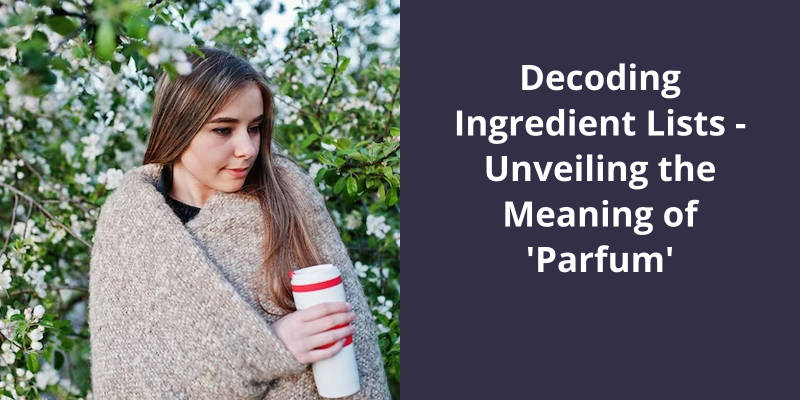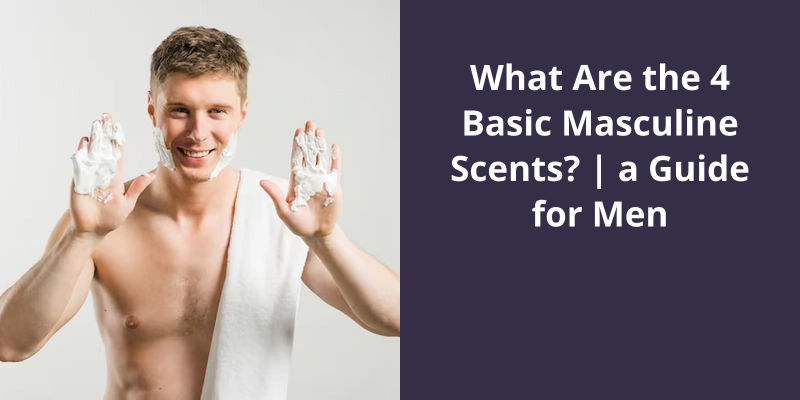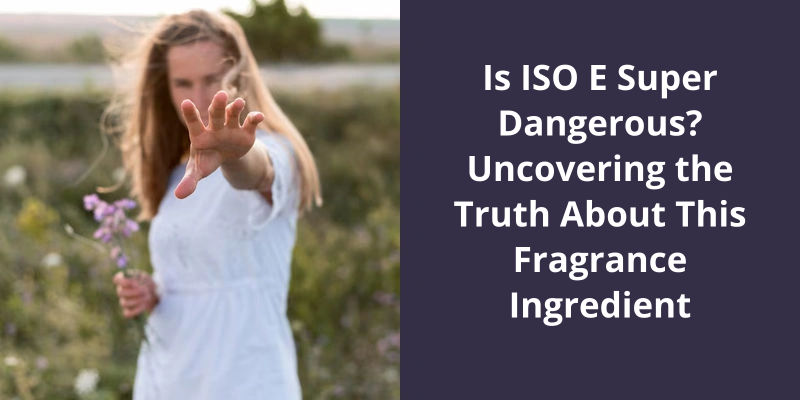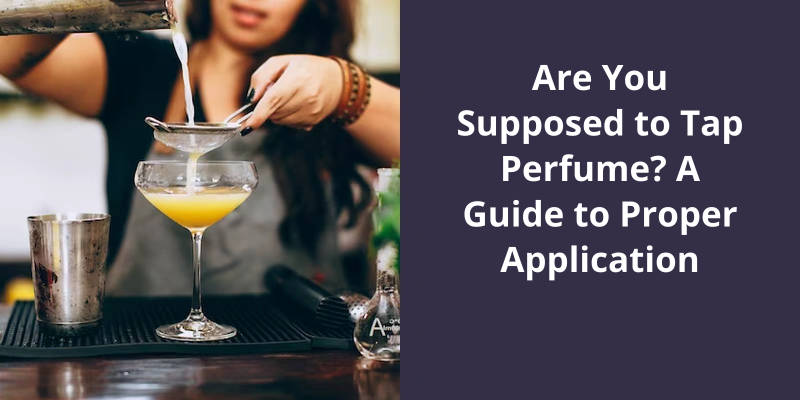Decoding ingredient lists, specifically on perfume products, involves understanding certain terms and their implications. The term “Parfum” on a product usually refers to a combination of various ingredients that make up the fragrance. The exact mixture is often kept secret, hence the use of one term. Essential oils, aroma compounds, and synthetic substances can all be included under this umbrella term. These mixtures are responsible for the scent in most skincare or cosmetic products. Manufacturers are not obliged to disclose the individual components of a “Parfum”, hence it is challenging for people with allergies or sensitivities to certain ingredients. However, it is considered safe for general use or the ingredients under “Parfum” might be listed in separate, if a brand wishes to be more transparent about their formula.

Is Parfum a Natural Ingredient?
Decoding Ingredient Lists: Unveiling the Meaning of Parfum
Is parfum a natural ingredient? The answer may surprise you. Despite the romantic connotations associated with the term, parfum is far from being a natural scent.
In reality, parfum is a chemically manufactured fragrance that gives products an indulgent feel. It’s also known as fragrance or perfume and is found in a wide range of personal care and cosmetic products, from perfumes and colognes to shampoos and body lotions. It’s purpose is to enhance the sensory experience and evoke pleasant emotions in consumers.
Although parfum can bring joy and delight through it’s alluring scents, it’s important to understand that it’s created through a complex combination of synthetic chemicals. These chemicals are meticulously selected and blended to create the desired fragrance. As a result, the term parfum on an ingredient list doesn’t indicate the presence of any natural or organic ingredients.
It’s longevity and stability make it an ideal choice for products that require a consistent scent throughout their shelf life.
Despite it’s synthetic nature, parfum is heavily regulated to ensure it’s safety for consumers. Regulatory agencies such as the International Fragrance Association (IFRA) impose strict guidelines and restrictions on the use of certain ingredients in fragrances to protect consumers from potential sensitivities or allergies.
The Process of Creating Parfum: How Are Synthetic Chemicals Selected and Blended to Create the Desired Fragrance?
Creating a parfum involves a meticulous process of selecting and blending synthetic chemicals to achieve the desired fragrance. Perfumers analyze the characteristics of different chemicals to determine which ones will create the desired scent profile.
The selection process takes into account factors such as the chemical’s volatility, stability, and compatibility with other ingredients. Synthetic chemicals are chosen to mimic natural scents or create unique, artificial fragrances.
Once the chemicals are chosen, they’re carefully blended in precise proportions to achieve the desired fragrance. This process requires expertise and knowledge of the interactions between different chemicals and their olfactory qualities.
The resulting parfum is a complex composition of carefully selected and blended synthetic chemicals that together create a unique and captivating fragrance.
When it comes to the percentage of fragrance in parfum, it can range from 15% to 40%, with most parfums falling within the 20% to 30% range. Known for their long-lasting scents that linger for six to eight hours, parfums are highly sought after and come with a heftier price tag due to their concentrated fragrance.
What Percentage of Fragrance Is in Parfum?
When it comes to decoding ingredient lists, it’s important to understand the meaning behind “Parfum.”. Many people are unaware of the fact that parfum refers to the concentration of fragrance in a product. It can range anywhere from 15% to 40%, with the most common concentration falling between 20% and 30%. This means that parfums are highly concentrated and provide a long-lasting scent.
Due to their high fragrance concentration, parfums have the longest staying power among all scents. On average, they can last anywhere from six to eight hours, making them the perfect choice for those who want their fragrance to linger throughout the day. However, it’s worth noting that individual body chemistry and factors like temperature and humidity can affect the longevity of a scent.
Because of their high concentration of fragrance, parfums also tend to command the highest price among all fragrance types. This is understandable, as the higher concentration of fragrance oils requires more expensive raw materials and a more intricate production process. However, many perfume enthusiasts are willing to invest in parfums for their superior quality and long-lasting scent.
Other common concentrations include eau de parfum, eau de toilette, and eau de cologne, each with varying levels of fragrance oils and therefore different longevity. Understanding these differences can help consumers make informed choices when purchasing fragrances.
However, it’s important to note that when it comes to fragrance ingredients, there’s another distinction to be made. While the concentration determines the strength and longevity of a scent, the actual ingredients used can vary greatly, resulting in different scent profiles and characteristics. Understanding these differences can help you make informed choices when selecting a fragrance that suits your preferences and needs.
What Is the Difference Between Parfum and Fragrance Ingredients?
Decoding ingredient lists is essential when it comes to understanding the meaning of Parfum. One key aspect to consider is the difference between parfum and fragrance ingredients. While both refer to the aromatic elements that create a fragrance, they’ve distinct characteristics that set them apart.
Parfum, also known as perfume or extrait de parfum, is the highest concentration of essential oils or aromatic compounds diluted in water and alcohol. Parfum typically contains between 15% and 40% aromatic compounds, making it the most potent and long-lasting option. Due to it’s high concentration, parfum is usually the most expensive option in the market.
These ingredients can vary widely, depending on the specific scent being formulated. Fragrance ingredients are commonly found in a range of products, including perfumes, body lotions, and scented candles. However, the concentration of these ingredients in these products is generally lower than in parfum.
Apart from parfum and fragrance ingredients, there are other terms often used to describe different fragrance concentrations. These include EdP (Eau de Parfum), EdT (Eau de Toilette), EdC (Eau de Cologne), and Aftershave. Each of these options has varying concentrations of aromatic compounds, which significantly impacts their performance and price.
EdC, or Eau de Cologne, is known for it’s lower concentration of aromatic compounds, ranging from 2% to 5%. Traditionally used in mens fragrances, EdC offers a lighter and fresher scent that can be applied more liberally. Lastly, aftershave generally contains the lowest concentration of aromatic compounds, usually around 1% to 3%. It’s commonly used as a post-shaving product to provide a subtle scent and soothe the skin.
It allows for a better understanding of the potency, longevity, and intended use of different products, while also providing insights into their pricing.
Conclusion
With over 3,000 chemicals being used as fragrances, it’s no wonder that fragrance is a ubiquitous ingredient in various personal care products. From perfumes to deodorants, the inclusion of fragrance adds a distinctive scent and enhances the overall sensory experience. However, it’s important for consumers to be aware of the potential allergenic or irritant properties of these undisclosed ingredients. So, the next time you encounter "parfum" on an ingredient list, remember that it signifies a mysterious concoction that contributes to the allure and allure and sensory appeal of your favorite skincare and cosmetic products.





